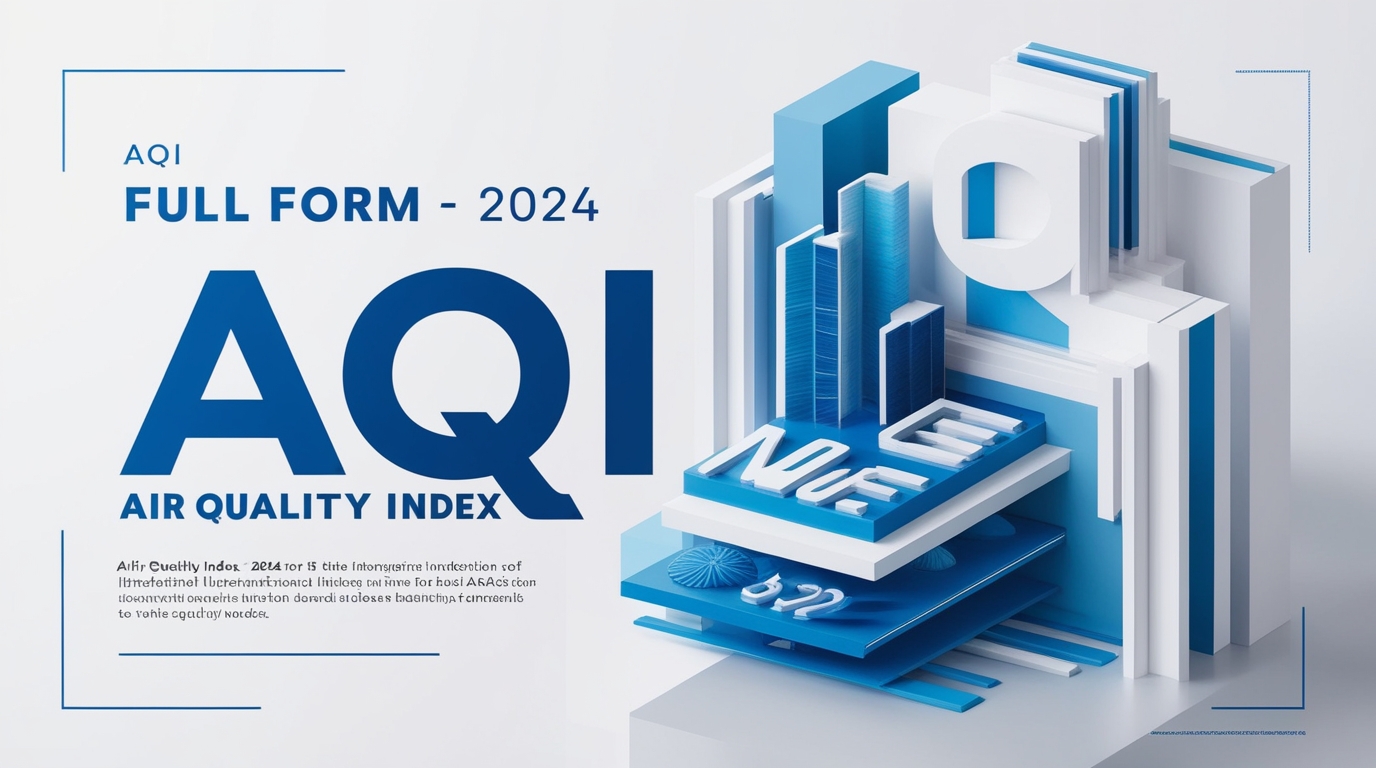- Air Quality Index (AQI): What It Means for Your Health and Environment
- UseFull Resources:
Air Quality Index (AQI): What It Means for Your Health and Environment
AQI Full Form – 2024, The Air Quality Index (AQI) is a vital tool used by governments and environmental organizations worldwide to inform the public about the quality of air in their regions. With the growing concerns about pollution and its effects on health, understanding the AQI has become more critical than ever. In this comprehensive guide, we will explore what AQI is, how it is calculated, its different levels, the pollutants it measures, and its impact on health and the environment.
What is the Air Quality Index (AQI)?
The Air Quality Index is a numerical scale that ranges from 0 to 500 and represents the quality of air in a specific area. The AQI score indicates the level of air pollution and its potential impact on health. Higher AQI values signify higher levels of pollution and increased risks to human health, while lower values represent cleaner air and a safer environment.
Key AQI Pollutants:
- Ground-level Ozone (O₃)
- Particulate Matter (PM2.5 and PM10)
- Carbon Monoxide (CO)
- Sulfur Dioxide (SO₂)
- Nitrogen Dioxide (NO₂)
These pollutants are harmful to both health and the environment, particularly in urban areas with high traffic, industrial activities, and limited green space.
How is the AQI Calculated?
The AQI is calculated based on the concentration levels of various air pollutants. Each pollutant is given an individual AQI value, and the overall AQI for a region is determined by the highest AQI value among all pollutants.
Steps in AQI Calculation:
- Measurement: Air quality monitors measure concentrations of the pollutants in micrograms per cubic meter (µg/m³) or parts per million (ppm).
- AQI Conversion: These concentrations are converted into AQI values using standard formulas developed by environmental agencies like the U.S. Environmental Protection Agency (EPA).
- Max AQI: The highest AQI value for any pollutant is used as the final AQI for the region.
AQI Categories and What They Mean
The AQI is divided into six categories, each representing a different level of health concern. The categories range from Good to Hazardous, based on the potential health impacts.
| AQI Level | Values | Air Quality | Health Impact |
|---|---|---|---|
| Good | 0-50 | Air quality is considered safe. | Air pollution poses little or no risk to health. |
| Moderate | 51-100 | Acceptable air quality. | Sensitive individuals (e.g., asthmatics) may experience minor effects. |
| Unhealthy for Sensitive Groups | 101-150 | Risky for sensitive groups. | Those with respiratory or heart conditions may experience adverse health effects. |
| Unhealthy | 151-200 | Health warning for everyone. | Everyone may begin to experience health effects, especially during outdoor activity. |
| Very Unhealthy | 201-300 | Emergency conditions. | Serious health effects are likely, particularly for vulnerable populations. |
| Hazardous | 301-500 | Severe risk to all populations. | Health warnings of emergency conditions; entire population likely to be affected. |
Health Effects of High AQI Levels
When the AQI level rises, the health risks increase, particularly for vulnerable groups like children, the elderly, and people with pre-existing health conditions. Each pollutant affects the body differently, but common symptoms include:
- Shortness of breath
- Wheezing and coughing
- Aggravated asthma
- Heart problems, especially in those with cardiovascular disease
- Irritation of the eyes, nose, and throat
Specific Pollutant Impacts:
- PM2.5: Small particulate matter can penetrate deep into the lungs and enter the bloodstream, causing respiratory and cardiovascular problems.
- Ozone (O₃): High ozone levels can lead to lung inflammation, reduced lung function, and aggravation of asthma.
Environmental Impact of Poor AQI
Beyond health concerns, a high AQI also affects the environment. The pollutants contribute to:
- Climate Change: Pollutants like CO₂ and methane lead to global warming and climate disturbances.
- Acid Rain: Sulfur dioxide and nitrogen dioxide can combine with water vapor to form acid rain, which damages crops, forests, and aquatic ecosystems.
- Smog Formation: Ground-level ozone contributes to the formation of smog, reducing visibility and harming wildlife.
AQI Trends Across the Globe
The AQI varies significantly between countries and cities. In urban areas, where industrial activities and vehicle emissions are high, AQI levels tend to be higher. For example:
- India: Major cities like Delhi often experience AQI levels in the “Unhealthy” to “Hazardous” range, especially during winter months due to crop burning and vehicular emissions.
- China: Industrial areas in northern China have consistently high AQI levels, leading to severe public health concerns.
- United States: While AQI levels are generally moderate to good in most regions, wildfires in states like California can cause hazardous spikes in particulate pollution.
How to Stay Safe When AQI is High
If you live in an area with consistently high AQI levels, taking precautions can significantly reduce the risk of adverse health effects:
- Monitor AQI: Use apps or websites to keep track of your local AQI.
- Limit Outdoor Activities: Stay indoors when AQI levels are high, especially during physical exertion.
- Use Air Purifiers: Install HEPA filters or air purifiers at home to reduce indoor pollution levels.
- Wear Masks: In extreme cases, wearing masks with N95 filters can reduce inhalation of harmful particulate matter.
Closing Remarks : Why Understanding AQI Matters
Understanding the Air Quality Index (AQI) is crucial for both your health and the environment. Poor air quality can lead to severe health issues, especially in vulnerable populations, and it has long-term impacts on the ecosystem. By monitoring AQI levels and taking preventive measures, individuals and communities can mitigate the adverse effects of air pollution.
Share this comprehensive guide with your network to spread awareness about the importance of air quality and how AQI can be a lifesaving tool in today’s increasingly polluted world!
If you Liked Reading our Blog Read More Blogs Here and Below is the Link to our WhatsApp channel Join it for the Latest Post Updates. (Read For WhatsApp Channel Privacy and Security Here).
UseFull Resources:
| Resources | Resources |
|---|---|
| Tooldar: Tooldar | Hemingway Editor: Hemingway Editor |
| Ilovepdf3: Ilovepdf3 | Grammarly: Grammarly |
| Adorepdf: Adorepdf | Coursera: Coursera |
| Custom Design Agency: Articon Design Agency | Udemy: Udemy |
| Google: Google | Khan Academy: Khan Academy |
| Yandex: Yandex | Wolfram Alpha: Wolfram Alpha |
| Baidu: Baidu | TED Talks: TED Talks |
| Medium: Medium | Skillshare: Skillshare |
| Quora: Quora | Canva: Canva |
| Duolingo: Duolingo | Figma: Figma |
| Nerdfitness: Nerdfitness | Trello: Trello |
| DeepL: DeepL | Notion: Notion |
| LinkedIn: LinkedIn | Asana: Asana |
| Stack Overflow: Stack Overflow | Mailchimp: Mailchimp |
| GitHub: GitHub | Zapier: Zapier |
Note : These Above Resources Are just for Educational and ease of use Purposes we neither Endorse them, they were working at the time of sharing.
.Disclaimer: The information presented in this blog is for educational and informational purposes only and should not be considered financial, Political, or cultural advice. All efforts have been made to ensure the accuracy of the content at the time of writing.
Think We Missed Something?
If you notice an error or have a suggestion, we encourage you to submit a correction. Help us keep our information up-to-date and reliable!











